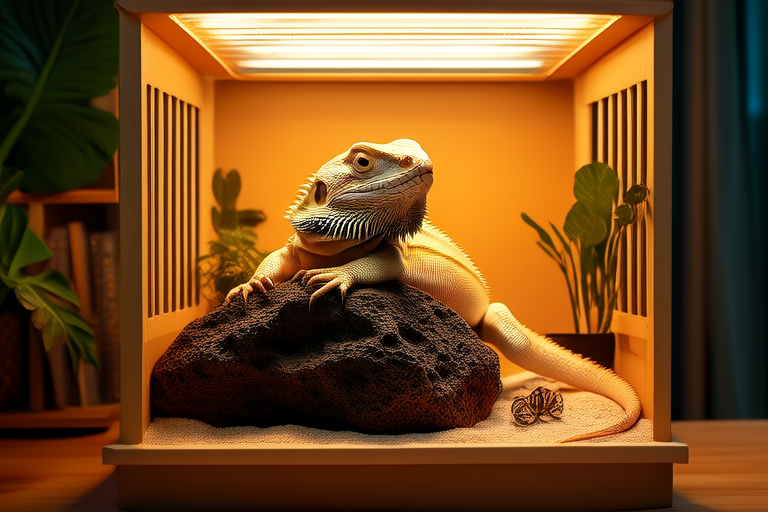How to Create the Perfect Habitat for Your Bearded Dragon at Home
Welcome to the exciting world of bearded dragon ownership! These charismatic reptiles are popular pets due to their friendly nature and relatively low maintenance requirements. However, providing them with a safe, comfortable, and stimulating environment is crucial for their health and well-being. This guide will walk you through the process of creating the perfect habitat for your bearded dragon, covering everything from selecting the right terrarium size to maintaining a clean and healthy living space.
Selecting an Appropriate Terrarium Size
The first step in setting up your bearded dragon’s home is choosing the right terrarium. Bearded dragons grow quickly, so it’s important to select a terrarium that can accommodate both their current and future sizes. A baby or juvenile bearded dragon requires at least a 20-gallon tank, but as they grow, they’ll need more space. Adult bearded dragons thrive in a 40-gallon or larger terrarium. The bigger the better, as it allows for a more natural temperature gradient and more hiding spots.
Setting Up the Right Lighting: UVB Exposure and Basking Spot Temperature
Bearded dragons require specific lighting conditions to thrive. They need ultraviolet B (UVB) light for calcium absorption and bone health. Without adequate UVB exposure, bearded dragons can develop metabolic bone disease, leading to weakened bones and other health issues. Choose a high-quality UVB lamp designed for reptiles, and place it over one end of the terrarium. The UVB light should cover about half of the tank, allowing your dragon to bask under it and move away if needed.
In addition to UVB lighting, bearded dragons also need a heat source to maintain optimal body temperature. Install a basking lamp on the same side as the UVB light, ensuring that the basking area reaches between 95°F and 110°F (35°C to 43°C). This warm spot mimics the sun’s rays and helps your bearded dragon digest its food properly. Use a thermometer to monitor the temperature accurately.
Creating a Balanced Temperature Gradient Within the Habitat
A crucial aspect of bearded dragon care is maintaining a balanced temperature gradient within the terrarium. One end should be warmer (the basking area) while the other end remains cooler. This allows your pet to thermoregulate by moving between the two areas. The cool side should be around 75°F to 85°F (24°C to 29°C), providing a comfortable retreat when your bearded dragon needs to cool down.
Choosing Suitable Substrates
Selecting the right substrate is vital for your bearded dragon’s safety and comfort. Avoid substrates like sand, which can cause impaction if ingested. Instead, opt for safer alternatives such as reptile carpet, paper towels, or eco-friendly bedding like coconut fiber or bark chips. These materials are easier to clean and less likely to pose a health risk to your pet.
Decorating with Hides and Climbing Structures
To enrich your bearded dragon’s environment and encourage natural behaviors, include hides and climbing structures. Hides provide a sense of security and privacy, especially during shedding periods. You can use commercially available hide boxes or create DIY options using safe materials like cork bark or ceramic planters.
Climbing structures, such as branches and rocks, allow your bearded dragon to exercise and explore. Make sure any climbing objects are securely placed and stable enough to support your dragon’s weight. Natural wood branches and smooth river rocks are excellent choices for adding texture and variety to the habitat.
Ensuring Proper Ventilation
Proper ventilation is essential for maintaining good air quality within the terrarium. Ensure that the enclosure has adequate airflow by using screen tops or vents that allow fresh air to circulate. Avoid using glass lids, as they can trap moisture and lead to respiratory problems. Regularly check for any signs of condensation inside the tank, which may indicate poor ventilation.
Maintaining Clean Water Sources
Bearded dragons rely on clean water for hydration and hygiene. Provide a shallow dish of fresh water daily, ensuring it is large enough for your dragon to soak in if desired. Check the water level frequently and replace it when dirty. Some bearded dragons prefer misting, which can be provided using a spray bottle or automatic misting system. Always ensure that the water is free from contaminants and bacteria.
Dietary Considerations Related to Habitat Setup
Your bearded dragon’s diet plays a significant role in maintaining its overall health. In addition to a varied diet rich in insects and vegetables, proper habitat setup supports digestive health. The basking spot’s warmth aids in digestion, while a balanced temperature gradient ensures that your dragon can regulate its metabolism effectively. Providing a stimulating environment with hides and climbing structures encourages activity, promoting better digestion and overall fitness.
Regular Maintenance Tips to Keep the Environment Healthy
Maintaining a clean and healthy environment is key to keeping your bearded dragon happy and thriving. Regular cleaning routines help prevent bacterial growth and reduce the risk of infections. Here are some tips for keeping your bearded dragon’s habitat in top condition:
- Spot Cleaning: Remove feces and uneaten food daily to prevent contamination.
- Deep Cleaning: Perform a thorough cleaning every few weeks, including disinfecting all surfaces and replacing substrate.
- Water Dish Maintenance: Clean and refill the water dish daily to ensure freshness.
- Light Bulb Replacement: Replace UVB and basking bulbs every six months, even if they still appear functional, to ensure consistent output.
- Monitor Humidity: Maintain humidity levels between 30% and 40% to prevent respiratory issues.
By following these guidelines, you’ll create a safe, comfortable, and stimulating habitat for your bearded dragon. Remember that each dragon is unique, so observe your pet’s behavior and adjust the environment accordingly. With proper care and attention, your bearded dragon will enjoy a long, healthy life in its new home.
